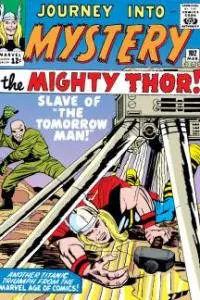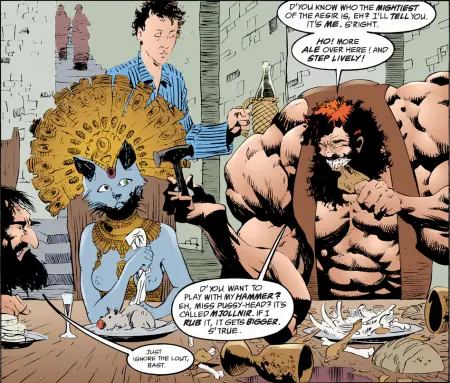Although there have been other side villains before, like Rebecca Hall’s Maya Hansen in Iron Man 3 or Karen Gillan as Nebula in the Guardians of the Galaxy movies, Cate Blanchett’s Hela in Thor: Ragnarok is the first female main villain in the movies of the Marvel Cinematic Universe. And what’s most important about Hela is how she’s personified by her femininity. In this way writer/director Taika Waititi plays into historical fears of the monstrous-feminine by undercutting Thor’s masculinity, weaving a throughline of castration anxiety throughout the film, while possibly commenting on recent stories in the comic books that have reframed the entire concept of Thor.
Released on November 3, Thor: Ragnarok is the 17th film in the Marvel Studios mega-franchise. Starring Chris Hemsworth as the titular character, Thor and the world he inhabits bears only a fleeting resemblance to Norse mythology. Here he is banished from Asgard by Hela, the Goddess of Death, who also turns out to be his older sister. During Hela’s introduction she destroys Mjolnir, the enchanted hammer that enhances Thor's power. In a twist that recontextualizes the whole series, it turns out Hela was the original wielder of the Mjolnir.
Depicted as a symbol of Thor’s virility for five films (including two Avengers movies), it is revealed that Mjolnir was originally a symbol of feminine power, not unlike how it’s recently been retconned in the comic books. And that power was used to further Asgard’s imperialism, a dark secret that Odin covers up when he locks Hela away for millennia and paints over the kingdom’s dark past. But a third-act twist shows Mjolnir isn’t the source of Thor’s strength after all, but only a channel for it, which downplays the question of gender.
Thor’s divine power has always had a fertility component. He was once considered a kind of patron saint of farmers because his control over storms was a key element to a good harvest and was linked to the consummation of marriage between sky god and earth goddess. Mythography scholar George Dumézil believed this to be the preservation by the common man of a side-effect of Thor, his fertilizing rain. Hilda Ellis Davidson, a scholar on Germanic and Celtic paganism, summarized this phenomenon:
The cult of Thor was linked up with men’s habitation and possessions, and with well-being of the family and community. This included the fruitfulness of the fields, and Thor, although pictured primarily as a storm god in the myths, was also concerned with the fertility and preservation of the seasonal round. In our own times, little stone axes from the distant past have been used as fertility symbols and placed by the farmer in the holes made by the drill to receive the first seed of spring. Thor’s marriage with Sif of the golden hair, about which we hear little in the myths, seems to be a memory of the ancient symbol of divine marriage between sky god and earth goddess, when he comes to earth in the thunderstorm and the storm brings the rain which makes the fields fertile. In this way Thor, as well as Odin, may be seen to continue the cult of the sky god which was known in the Bronze Age.
Hela, meanwhile, first appeared in Journey into Mystery #102 (March 1964), written by Stan Lee with art by Jack Kirby. She is based on Hel, a being in Norse mythology who presides over an afterlife of the same name located in Niflheim. Hel is often referred to as a daughter of Loki, so there is precedent for there to be a familial connection, and is often described as having been appointed by Odin to her position.
So while Hela is the Goddess of Death, Thor can in many ways be interpreted as the God of Life. Surprisingly this doesn’t come into play in the movie, as there could have been a compelling dichotomy between Thor and Hela. And since life in this case is very much associated with strength and manhood, that of course means that Mjolnir is a not-so-subtle phallic metaphor.
Don’t blame me. Neil Gaiman put the idea in my head.
As far back as the first Thor film there’s been this underlying conceit of Thor’s animus being defined through Mjolnir. So the idea there was, of course, about how an impotent man gets his mojo back. In Ragnarok it’s more literalized, with him essentially being castrated but having to become an even stronger phallus.
So what does that make Hela? She’s a fascinating character from a thematic standpoint, because she originally wielded Mjolnir. And although this certainly isn’t a straight adaptation of the comics, one of the screenwriters is Christopher Yost, a noted comic book writer, so he may have had the recent Jason Aaron run on his mind.
In the “Original Sin” storyline in 2014, Thor had a crisis of confidence that rendered him unworthy of Mjolnir. It ended up being taken up by Jane Foster, Thor’s ex-girlfriend (played by Natalie Portman in the movies) who became the new Thor, with the original now dubbed Odinson. And it’s not as simple as human woman is worthy and gains power: Aaron added the nuance that Mjolnir contains something called the God Tempest, otherwise known as the Mother of Thunder. Previously, the backstory was that Odin had Mjolnir forged from an enchanted, unbreakable metal known as Uru, and since it’s so powerful it could only be forged in the heart of a star. Thor even mentions this in Ragnarok, so that’s consistent with the comics.
But what Aaron has added is the God Tempest being a leftover sentient bit of the Big Bang that was roaming the universe millions of years ago destroying planets, only to ultimately be trapped inside of Mjolnir. Basically, the God Tempest arrived at Asgard and Odin fought it for days, until finally wearing it down and then trapping it in a nugget of Uru. He then gave it to the dwarves, it was turned into Mjolnir and powered by the God Tempest, so Odin put a spell on it so no one would wield it. But, of course, millennia later Thor proved worthy, and the rest is history. Except it retroactively reveals that a totem of male power was actually a woman’s all along. And that Odin essentially beat a hysterical woman into submission and then trapped her forever.
Ragnarok plays around with Odin having his own original sin, covering up Asgard's past and trapping Hela instead of the God Tempest*. Except the filmmakers reframe it that Mjolnir is just a channel for the power of the person, so it was only amplifying Hela’s femininity and Thor’s masculinity. Even so, Thor still conflates Mjolnir with his masculinity, so what does that make Hela if she destroys it?
None other than a vagina dentata.
“Vagina dentata” is Latin for toothed vagina and describes how, in ancient folklore around the world, a woman’s vagina was said to contain teeth. This implies that sexual intercourse might emasculate a man, and that a strong man must conquer a dangerous woman with a phallus, breaking the teeth. In scholarly studies it’s been closely associated with powerful women, such as Medusa of Greek mythology. As Barbara Creed explains in her article, “Horror and the Monstrous-Feminine: An Imaginary Abjection”:
Classical mythology also was populated with gendered monsters, many of which were female. The Medusa, with her ‘evil eye,’ head of writhing serpents and lolling tongue, was queen of the pantheon of female monsters; men unfortunate enough to look at her were turned immediately to stone.
It is not by accident that Freud linked the sight of the Medusa to the equally horrifying sight of the mother’s genitals, for the concept of the monstrous-feminine, as constructed within/by a patriarchal and phallocentric ideology, is related intimately to the problem of sexual difference and castration.
Creed goes on to explain that Freud argued that “Medusa’s head takes the place of a representation of the female genitals,” with this difference in sexuality invoking “castration anxiety in the male spectator.”
Hela’s massive headdress is not unlike Medusa’s unruly hair. And Hela is even associated with vaginal imagery in other ways, such as emerging from a hole in her first appearance. So Ragnarok has the subtext of Hela attempting to castrate Thor, and him having to overpower her with his potency.
 The filmmakers do, however, go out of their way to not demonize women by having Valkyrie, and the existence of all the Valkyries, act as a source of heroism who are admired by Thor. But Hela represents a very specific kind of portrayal of women in fiction, and that’s Creed’s aforementioned monstrous-feminine. She expands on this concept in her 1993 book The Monstrous-Feminine: Film, Feminism, Psychoanalysis (a must-read, along with Carol Clover’s Men, Women and Chain Saws, which came up with the idea of the “final girl”).
The filmmakers do, however, go out of their way to not demonize women by having Valkyrie, and the existence of all the Valkyries, act as a source of heroism who are admired by Thor. But Hela represents a very specific kind of portrayal of women in fiction, and that’s Creed’s aforementioned monstrous-feminine. She expands on this concept in her 1993 book The Monstrous-Feminine: Film, Feminism, Psychoanalysis (a must-read, along with Carol Clover’s Men, Women and Chain Saws, which came up with the idea of the “final girl”).
Her focus is mostly on the horror genre, but it can be extended outward from there. Basically, Creed argues there are several kinds of monstrous-feminine: the Archaic Mother in Alien (1979), Possessed Monster in The Exorcist (1973), Monstrous Womb in The Brood (1979), Vampire in The Hunger (1983), Witch in Carrie (1976), Femme Castratrice in I Spit on Your Grave (1978) and Sisters (1973), and the Castrating Mother in Psycho (1960). Essentially Hela is a Femme Castratrice, with Mjolnir being taken from her as a violent assault, a rape or even a form of female genital mutilation. In the present she’s out for revenge and targets the fruit of Odin’s labors, Asgard and his male heir Thor, and specifically Thor’s masculinity.
These two examples of hypermasculinity, Odin and Thor, encounter a woman who is characterized by her passion, a hysterical woman, in the old stereotypical sense of the word, and they experience castration anxiety. The only answer, much like the God Tempest in the comics, is to lock her away and then kill her so she won’t spread her feminine influence across the universe.
*It also bears a striking resemblance to the long-lost sister Angela storyline that was also expanded upon during “Original Sin,” but that’s mostly surface-level texture.
Get Original Sin Part 1 at Amazon
Get The Monstrous Feminine at Bookshop or Amazon

About the author
A professor once told Bart Bishop that all literature is about "sex, death and religion," tainting his mind forever. A Master's in English later, he teaches college writing and tells his students the same thing, constantly, much to their chagrin. He’s also edited two published novels and loves overthinking movies, books, the theater and fiction in all forms at such varied spots as CHUD, Bleeding Cool, CityBeat and Cincinnati Magazine. He lives in Cincinnati, Ohio with his wife and daughter.








